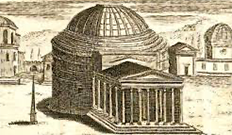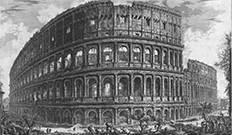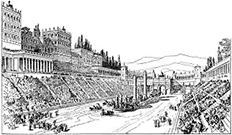Roman Architecture
Roman architecture took many forms and incorporated many innovations. The result was construction on a very large scale. 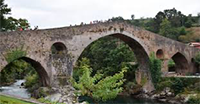
Perhaps the most fundamental part of Roman architecture was the arch, borrowed from the Etruscan culture that Rome initially emulated and then replaced in Italy. A key stone in the center held the arch components wedge-shaped blocks known as voussoirs) together and distributed the weight and eliminated the need for a number of interior support posts. The Greek system of building relied heavily on the post and lintel system, with a horizontal element resting on columns or another form of upright. Early buildings were made of wood. Even later buildings, made out of stone, could be only so big–as big as the supports would allow. Employing the arch allowed Roman architects to create larger and larger buildings. The advent of concrete as a building material, beginning in the late 2nd Century B.C., allowed Roman architects to design buildings on a colossal scale. The Romans made their concrete from a combination of sand, water, lime mortar, a kind of ash known as pozzolana, and various building materials such as brick or travertine (a kind of limestone) or the native volcanic stone tufa (or tuff). The Romans were known to have included horse hair, to help guard against cracked concrete and, in colder climates, animal blood to guard against the cold. Concrete started out as a liquid and so could be poured into a mold and then left to dry. Roman concrete would hold even underwater. Marble was the choice of building material in structures as early as the Temple of Jupiter Stator in Rome, in 146 BC. However, it wasn't until the glory days of the Empire that the Romans preferred marble as a sign of their ostentatious nature. Roman builders still used bricks and stone, although they were no longer the primary building material. 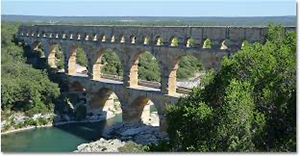
The development of concrete as a relatively cheap and readily available building material and the advent of the arch made possible construction of things like aqueducts, which brought fresh water to Rome and other cities from the far-away hinterlands, and domes, which revolutionized the possibilities of building. Temples, palaces, and baths had domes atop their vast interiors. The use of the concrete dome eliminated the requirement of interior ballast, and so the inside of a structure could be as empty as possible of stone columns and wood supports. 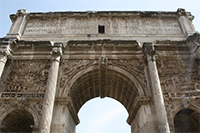
The dome, of course, built (quite literally) upon the vault, a Roman innovation that, like the arch, improved on Etruscan techniques. The vault was basically an arch-shaped ceiling that employed the same weight distribution model as the pillar arch. Again, no intermediate posts were needed. Roman emperors such as Titus and Septimius Severus were quite fond of arches and had large ones built in in the Roman Forum in order to celebrate their various conquests. Temples, too, became quite lavish and were succeeded by the basilica as a form of worship building. Perhaps the most enduring temple built in Rome was the Pantheon, which had a 142-foot-long domed ceiling in which was placed a 27-foot-wide oculus.
All of these architectural materials and methods enabled the Romans to build larger and larger buildings like the Colosseum, which endure as symbols of the roman architectural majesty. As well, the use of vaulted construction allowed the Romans to build amphitheaters away from hillsides, which had been a requirement in the days of Ancient Greece. The Circus Maximus was one of the most well-known racetracks from Roman times. One of the largest baths ever made were the Baths of Caracalla, in Rome. Covering 62 acres, they could accommodate up to 8,000 bathers a day. The complex also had other buildings, such as a library, and areas for other physical activities, such as walking and other forms of exercise. 
In terms of living space, many Romans called quite simple spaces home, such as the multi-story apartment blocks known as insulae. Those who had money to spend on lavish villas and other symbols of disposable income could employ various building techniques to their living areas, such as the inclusion of an atrium and/or a walled garden. Emperors, of course, seemed to have unlimited funds and often had built enormous buildings and complexes; one of the most well-known of those was the Domus Aurea, the Golden House of the emperor Nero. The emperor Diocletian, too, had built a very large palace at Spalato that he called home for several years. Closer to Rome was the palatial Villa of Hadrian. On a more fundamental level, the Roman road was perhaps the most wide-ranging innovation of all. The Romans built more than 250,000 miles of roads that criss-crossed the Empire. A combination of the arch and concrete also made possible some very long and very stable bridges, facilitating the crossing of rivers by traders and troops. |
|
Social Studies for Kids
copyright 2002–2025
David White



